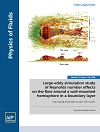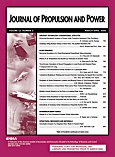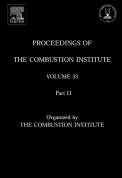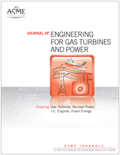
FLOW TURBULENCE AND COMBUSTION
Scope & Guideline
Fostering collaboration in the study of turbulent phenomena.
Introduction
Aims and Scopes
- Turbulence Modelling and Simulation:
The journal emphasizes the development and application of advanced turbulence models, including Direct Numerical Simulation (DNS) and Large Eddy Simulation (LES), to capture complex flow phenomena and interactions. - Combustion Dynamics and Modelling:
Research on combustion processes, focusing on the dynamics of flame propagation, stability, and emissions, is a core theme. This includes studies on premixed and non-premixed flames, as well as innovative combustion technologies. - Fluid-Structure Interaction:
The journal explores the interactions between fluid flows and structural components, particularly in applications such as aerospace and mechanical systems, where aerodynamic and hydrodynamic effects are crucial. - Experimental Techniques and Diagnostics:
There is a strong emphasis on experimental research, utilizing techniques such as Particle Image Velocimetry (PIV), Laser Doppler Velocimetry (LDV), and advanced imaging methods for detailed flow characterization. - Data-Driven Approaches in Turbulence and Combustion:
The integration of machine learning and data-driven methodologies into turbulence and combustion research is increasingly highlighted, aiming to enhance predictive capabilities and model development.
Trending and Emerging
- Advanced Turbulence Modelling Techniques:
An increased focus on hybrid models that integrate machine learning with traditional turbulence modelling approaches is evident. This trend reflects the growing interest in leveraging computational advancements for improved accuracy. - Hydrogen and Alternative Fuels Research:
Research exploring the combustion characteristics of hydrogen and other alternative fuels is on the rise, driven by the global push towards cleaner energy sources and sustainable combustion technologies. - Aeroacoustics and Noise Control:
The journal is seeing a significant uptick in studies addressing aeroacoustics, particularly the noise generated by turbulent flows and combustion processes, highlighting the importance of noise control in engineering applications. - Multi-Phase Flow Dynamics:
Research on multi-phase flows, including interactions between liquids and gases in combustion processes, is gaining momentum, reflecting a broader interest in complex fluid dynamics in industrial applications. - Real-Time Monitoring and Control:
Emerging themes include real-time monitoring and control of combustion processes using advanced sensors and data analytics, emphasizing the importance of operational efficiency and emissions reduction.
Declining or Waning
- Traditional RANS Modelling:
Research centered on Reynolds-Averaged Navier-Stokes (RANS) turbulence models is becoming less frequent as the field shifts towards more sophisticated approaches like LES and DNS that provide higher fidelity results. - Basic Combustion Studies:
There seems to be a decline in basic studies focused solely on combustion without the integration of turbulence dynamics. Recent publications favor investigations that combine combustion with complex flow interactions. - Conventional Experimental Methods:
While experimental research remains significant, there is a noticeable reduction in studies employing traditional experimental methods, as newer diagnostic techniques and computational methods gain traction.
Similar Journals

PHYSICS OF FLUIDS
Advancing the Frontiers of Fluid DynamicsPHYSICS OF FLUIDS is a premier journal published by AIP Publishing that serves as a vital resource for the fluid mechanics community. With an impressive impact factor and a consistent ranking in the Q1 quartile across multiple related disciplines—including Computational Mechanics, Condensed Matter Physics, Fluid Flow and Transfer Processes, Mechanical Engineering, and Mechanics of Materials—this journal is renowned for disseminating high-quality research in the dynamic field of fluid dynamics. Covering a wide range of topics, from fundamental fluid mechanics to advanced computational modeling, PHYSICS OF FLUIDS plays a crucial role in advancing understanding and fostering innovation in both academic and industrial applications. With its strong reputation and significant readership, this journal is essential for researchers, professionals, and students seeking to stay updated on the latest developments in fluid physics.

COMBUSTION SCIENCE AND TECHNOLOGY
Unveiling the Science Behind Combustion ProcessesCOMBUSTION SCIENCE AND TECHNOLOGY, published by Taylor & Francis Inc, is a pivotal journal in the fields of Chemical Engineering and Chemistry, with a robust history spanning from 1969 to 2024. With an established impact factor and a strong reputation reflected in its Q2 ranking in both Chemical Engineering and Chemistry, this journal serves as an essential resource for researchers and professionals dedicated to the intricacies of combustion processes and energy technologies. The journal also holds commendable rankings in Energy Engineering, Fuel Technology, and Physics and Astronomy, showcasing its interdisciplinary relevance. While currently not an open-access publication, it offers a wealth of knowledge through its meticulously peer-reviewed articles, which are crucial for advancing understanding and innovation in combustion science. With a commitment to promoting rigorous research and fostering scholarly communication, COMBUSTION SCIENCE AND TECHNOLOGY is indispensable for anyone seeking cutting-edge insights into combustion phenomena and their applications in various engineering fields.

COMBUSTION EXPLOSION AND SHOCK WAVES
Exploring the Dynamics of Energy and ExplosionsCOMBUSTION EXPLOSION AND SHOCK WAVES, published by MAIK NAUKA/INTERPERIODICA/SPRINGER, is a peer-reviewed journal that has been a cornerstone in the fields of combustion science and shock wave dynamics since its inception in 1965. With a broad scope encompassing chemical engineering, energy technology, and physics, this journal plays a pivotal role in disseminating groundbreaking research that drives advancements in both theory and application. Despite its classification in the third quartile across several categories as of 2023, the journal continues to attract contributions that address critical challenges and innovations in combustion-related phenomena. Researchers and professionals across multiple disciplines are encouraged to submit their findings, as the journal provides a valuable platform for sharing knowledge and fostering collaboration. The editorial board is committed to maintaining high standards of quality and relevance, which is reflected in its ongoing influence in these interdisciplinary and rapidly evolving fields. While the journal is not open access, it offers a wealth of insights and scholarly work that is vital for both academic inquiry and practical applications. From the vibrant heart of New York City, COMBUSTION EXPLOSION AND SHOCK WAVES aims to inspire and inform, serving as an essential resource for those dedicated to understanding and innovating in the realm of combustion science.

JOURNAL OF PROPULSION AND POWER
Fueling Progress in Aerospace EngineeringJOURNAL OF PROPULSION AND POWER, published by the American Institute of Aeronautics and Astronautics, is a premier peer-reviewed journal dedicated to the advancement of knowledge in the fields of aerospace engineering, mechanical engineering, and fuel technology. With an impressive impact factor and ranked in the Q1 and Q2 categories for various relevant fields, the journal serves as a vital resource for researchers, professionals, and students alike who are looking to stay abreast of the latest innovations and breakthroughs in propulsion systems and power generation methodologies. Established in 1985, the journal covers a wide range of topics, ensuring a comprehensive understanding of propulsion technologies from atmospheric to space applications. Its robust Scopus rankings highlight its significance in the academic community, establishing it as a leading forum for sharing pivotal research findings and fostering collaborative dialogues that drive the aerospace industry forward. Located in Reston, Virginia, the journal does not currently offer open access options, yet it remains accessible to a vast audience via academic institutions and libraries. As we move further into the 21st century, the JOURNAL OF PROPULSION AND POWER continues to be an indispensable tool for the exploration and evolution of propulsion and power systems.

PROCEEDINGS OF THE COMBUSTION INSTITUTE
Exploring the Frontiers of Combustion SciencePROCEEDINGS OF THE COMBUSTION INSTITUTE, published by Elsevier Science Inc, is a premier platform for dissemination of advanced research in the fields of combustion science, engineering, and related technologies. With an ISSN of 1540-7489 and an E-ISSN of 1873-2704, this journal holds a prestigious position within the academic community, as evidenced by its top-tier Q1 rankings in Chemical Engineering, Mechanical Engineering, and Physical and Theoretical Chemistry for 2023. The journal is recognized for its rigorous peer-review process and aims to publish high-quality, impactful research that drives innovation and knowledge in combustion phenomena. Researchers and professionals can engage with cutting-edge findings that address critical challenges and explore novel solutions in this vital area of study. Although it does not offer open access, its subscription model ensures wide accessibility to institutions and experts seeking profound insights into combustion dynamics.

JOURNAL OF ENGINEERING FOR GAS TURBINES AND POWER-TRANSACTIONS OF THE ASME
Connecting Academia and Industry in Energy InnovationJournal of Engineering for Gas Turbines and Power - Transactions of the ASME, published by the esteemed American Society of Mechanical Engineers (ASME), is a leading interdisciplinary journal dedicated to advancing the fields of energy engineering, aerospace, nuclear energy, and mechanical engineering. With an impressive history dating back to 1960 and continuing its contributions through 2024, this journal boasts a Q2 ranking in multiple engineering categories, reflecting its strong impact on both academia and industry. Although not an open-access journal, it provides invaluable insights and research findings that cater to the needs of professionals, researchers, and students alike. The journal's ISSN is 0742-4795 with an E-ISSN of 1528-8919, ensuring widespread visibility in the global academic community. Indexed in Scopus, it ranks notably within its fields—21st in Nuclear Energy and Engineering and 51st in Aerospace Engineering—underscoring its relevance and contribution to critical technological advancements. Researchers in this domain will find the journal a vital resource for innovative studies, practical applications, and the latest developments related to gas turbines and power generation.

Journal of Hydrodynamics
Empowering Researchers Through High-Impact HydrodynamicsWelcome to the Journal of Hydrodynamics, a premier academic journal dedicated to pioneering research in the fields of Condensed Matter Physics, Mechanical Engineering, Mechanics of Materials, and Modeling and Simulation. Published by Springer, this esteemed journal has been a vital resource since its inception in 1990 and boasts a notable Q1 ranking across its relevant categories, underscoring its importance in advancing knowledge and innovation. With a robust Scopus ranking reflecting its impact—such as being in the 82nd percentile in Mathematics: Modeling and Simulation and the 75th percentile in various engineering disciplines—the journal serves as a critical platform for researchers, professionals, and students. While not currently an open-access publication, the Journal of Hydrodynamics remains committed to fostering scholarly dialogue and disseminating high-quality research that shapes the future of its field. Our mission is to provide a comprehensive forum for the discussion of theoretical and applied hydrodynamics, potentially influencing both academic inquiry and practical applications worldwide.

JOURNAL OF ENGINEERING PHYSICS AND THERMOPHYSICS
Advancing the Frontiers of Engineering Physics and ThermophysicsJOURNAL OF ENGINEERING PHYSICS AND THERMOPHYSICS, published by Springer, is a vital resource for researchers and professionals in the fields of engineering physics and thermophysics. With an ISSN of 1062-0125 and an E-ISSN of 1573-871X, this esteemed journal has been disseminating high-quality research since its inception, covering critical advancements in both condensed matter physics and various engineering disciplines. Despite its classification within the third quartile in both Scopus categories for 2023, the journal remains a significant conduit for innovative studies that push the boundaries of knowledge in thermal and physical engineering, with converged years spanning from 1992 to 1997 and 2004 to 2024. The journal does not offer open access, which means subscribers and institutions have exclusive access to its rich content. As the field continues to evolve, JOURNAL OF ENGINEERING PHYSICS AND THERMOPHYSICS plays an essential role in fostering scholarly discussions and supporting the academic community in tackling contemporary engineering challenges.

AIAA JOURNAL
Pioneering Discoveries in Aerospace Engineering ExcellenceAIAA JOURNAL, published by the American Institute of Aeronautics and Astronautics, stands as a premier peer-reviewed platform for cutting-edge research in the field of aerospace engineering. With an esteemed Q1 classification in the Aerospace Engineering category and a notable rank within the top 20% of its field according to Scopus, this journal has become an essential resource for researchers, professionals, and students alike. Spanning over six decades of impactful scholarship from 1963 to 2024, the AIAA JOURNAL contributes significantly to the advancement of aerospace technologies and methodologies. While it does not offer open access, its rigorous editorial standards and impactful articles ensure that it remains a vital source for those seeking to stay at the forefront of aerospace innovation. Explore the rich tradition of excellence and stay informed on the latest discoveries that shape the world of flight and space exploration.

Applications in Energy and Combustion Science
Fueling Knowledge in Energy and Combustion ScienceWelcome to Applications in Energy and Combustion Science, a premier open-access journal published by ELSEVIER that has been at the forefront of research since 2020. With the ISSN 2666-352X, this journal is dedicated to advancing the knowledge and application of energy technologies and combustion systems, reflecting a strong commitment to the evolving demands of the field. Based in the United Kingdom and recognized for its robust contributions, it has achieved noteworthy status in the 2023 rankings: a Q1 classification in both Chemical Engineering (miscellaneous) and Fuel Technology, alongside a Q2 standing in Energy (miscellaneous). Researchers will find it a significant platform, with Scopus rankings placing it among the top tiers in various categories. This journal offers an essential resource for professionals and students aiming to stay abreast of innovative developments and applications in the critical areas of energy and combustion, ensuring broad accessibility and dissemination of research findings.